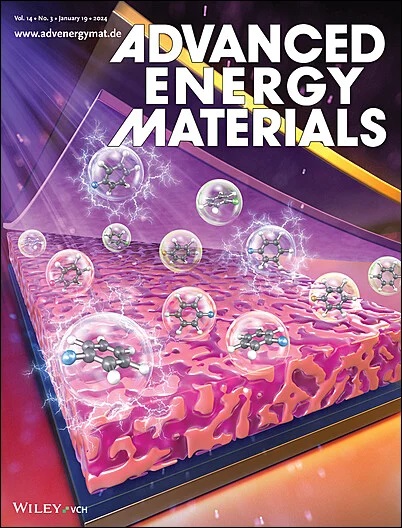Enhancing Fast-Charging Capability of Thick Electrode in Lithium-Ion Batteries Through Electronic/Ionic Hybrid Conductive Additive Engineering
IF 24.4
1区 材料科学
Q1 CHEMISTRY, PHYSICAL
引用次数: 0
Abstract
The attainment of lithium-ion batteries (LIBs) featuring high energy density necessitates the anode to exhibit substantial mass loading and thickness. However, this presents a formidable challenge for fast charging due to inferior Li-ion transport capability throughout the electrode depth, resulting in diminished capacity, reduced lifespan, and potential safety hazards. Here, an alternative strategy is put forth that utilizes an electronic/ionic hybrid conductive additive as a substitution for the conventional conductive reagent. This particular additive showcases carbon black (CB) particles adorned with ultrathin red phosphorus nanolayer (≈2 nm) (CB-P), which undergo in situ transformation into stable ultrathin lithium phosphide (Li3P) nanolayer-coated CB particles during the operation of the battery. Benefiting from the significant contribution of Li+ conductive enhancement, the introduction of Li3P enables significantly increased apparent Li+ transference number and similar ionic conductivity compared to CB additive (0.67 vs 0.42, 5.2 vs 4.1 mS cm−1). Notably, the pouch cell with graphite anode and CB-P additive demonstrates a high capacity filling ratio of 83.5% within 15 min (4C, relative to that at 0.5C) under a high anode loading of 14.4 mg cm−2 (4.4 mAh cm−2 at 0.5C). The full pouch cell with SiOx anode and CB-P additive exhibits an 82.1% capacity refilling at 4C charging rate (15 min, relative to that of 0.2C). In consideration of the superior compatibility with current electrode processing, the CB-P additive can serve as a direct replacement for traditional CB additives in existing batteries and boost the implementation of fast-charging LIBs with high energy density.

通过电子/离子混合导电添加剂工程提高锂离子电池厚电极的快速充电能力
锂离子电池(LIBs)的高能量密度要求阳极具有足够的质量负载和厚度。然而,由于锂离子在整个电极深度的传输能力较差,这给快速充电带来了巨大的挑战,导致容量减少,寿命缩短,并存在潜在的安全隐患。本文提出了一种替代策略,即利用电子/离子杂化导电添加剂代替传统的导电试剂。这种特殊的添加剂展示了涂有超薄红磷纳米层(≈2 nm) (CB- p)的炭黑(CB)颗粒,在电池运行过程中,炭黑(CB)颗粒在原位转化为稳定的超薄磷化锂(Li3P)纳米层涂覆的炭黑颗粒。得益于Li+导电性增强的显著贡献,与CB添加剂相比,Li3P的引入显著增加了Li+的表观转移数和相似的离子电导率(0.67 vs 0.42, 5.2 vs 4.1 mS cm−1)。值得注意的是,石墨阳极和CB-P添加剂的袋状电池在14.4 mg cm - 2 (0.5C时4.4 mAh cm - 2)的高负极负载下,在15分钟(4C,相对于0.5C时)的高容量填充率为83.5%。采用SiOx阳极和CB-P添加剂的全袋电池在4C充电速率(15 min,相对于0.2C充电速率)下的再充放电容量为82.1%。考虑到与电流电极加工的优越兼容性,CB- p添加剂可以直接替代现有电池中的传统CB添加剂,并促进高能量密度快速充电的锂离子电池的实现。
本文章由计算机程序翻译,如有差异,请以英文原文为准。
求助全文
约1分钟内获得全文
求助全文
来源期刊

Advanced Energy Materials
CHEMISTRY, PHYSICAL-ENERGY & FUELS
CiteScore
41.90
自引率
4.00%
发文量
889
审稿时长
1.4 months
期刊介绍:
Established in 2011, Advanced Energy Materials is an international, interdisciplinary, English-language journal that focuses on materials used in energy harvesting, conversion, and storage. It is regarded as a top-quality journal alongside Advanced Materials, Advanced Functional Materials, and Small.
With a 2022 Impact Factor of 27.8, Advanced Energy Materials is considered a prime source for the best energy-related research. The journal covers a wide range of topics in energy-related research, including organic and inorganic photovoltaics, batteries and supercapacitors, fuel cells, hydrogen generation and storage, thermoelectrics, water splitting and photocatalysis, solar fuels and thermosolar power, magnetocalorics, and piezoelectronics.
The readership of Advanced Energy Materials includes materials scientists, chemists, physicists, and engineers in both academia and industry. The journal is indexed in various databases and collections, such as Advanced Technologies & Aerospace Database, FIZ Karlsruhe, INSPEC (IET), Science Citation Index Expanded, Technology Collection, and Web of Science, among others.
 求助内容:
求助内容: 应助结果提醒方式:
应助结果提醒方式:


